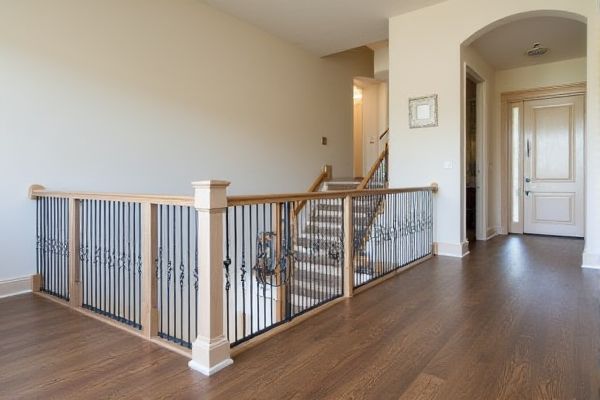
Double railing offers enhanced safety and support compared to single railing, making it ideal for staircases and balconies where extra security is required. Explore the article to understand which railing option best suits Your needs and environment.
Table of Comparison
| Feature | Double Railing | Single Railing |
|---|---|---|
| Safety | Higher safety with two barriers | Basic safety with one barrier |
| Cost | More expensive due to extra materials | More affordable and budget-friendly |
| Installation | Complex and time-consuming | Simple and quicker to install |
| Durability | Increased durability with dual support | Standard durability |
| Aesthetics | Modern, layered look | Minimalistic, clean design |
| Maintenance | Requires more upkeep | Less maintenance needed |
Introduction to Railing Systems
Double railing systems provide enhanced safety and stability by incorporating two horizontal bars, often used in high-traffic or elevated areas, whereas single railing systems feature one horizontal bar suitable for standard residential or light commercial applications. The choice between double and single railings depends on factors like required load capacity, building codes, and aesthetic preferences, ensuring compliance with safety standards such as OSHA or IBC. Materials commonly used include steel, aluminum, and wood, each offering varying levels of durability and maintenance requirements for both railing types.
Overview of Single Railing
Single railing systems provide a streamlined and cost-effective solution for various architectural applications, offering both safety and aesthetic appeal with a solitary horizontal or vertical barrier. Commonly constructed from materials such as steel, aluminum, wood, or glass, single railings are ideal for staircases, balconies, and decks where minimalistic design is preferred. Their straightforward installation and reduced material use make single railings a popular choice for residential and commercial projects seeking basic fall protection without compromising on visual openness.
Overview of Double Railing
Double railing systems provide enhanced safety and stability by incorporating two parallel railings, typically used in environments requiring extra support, such as staircases or balconies with higher fall risks. Unlike single railings that offer basic protection, double railings increase grip options and improve overall structural integrity, making them ideal for homes or public spaces where safety is paramount. You benefit from increased security and aesthetic appeal with double railing installations, ensuring both functionality and style.
Key Differences Between Double and Single Railing
Double railing features two parallel rails providing enhanced safety and stability, whereas single railing includes only one rail, offering a minimalist design. Double railings are typically used in areas requiring extra support, such as staircases or balconies, while single railings are common in decorative or less hazardous zones. Your choice depends on the level of security needed and the architectural style preferred.
Safety Considerations: Double vs Single Railing
Double railing offers enhanced safety by providing an additional barrier that reduces the risk of falls, especially in high-traffic or elevated areas, compared to single railing systems. Your choice of double railing can improve stability and support, making it ideal for homes with children or elderly occupants needing extra protection. Single railing may suffice for low-risk zones but lacks the comprehensive security features inherent in double railing designs.
Aesthetic Impact of Railing Choices
Double railings create a more substantial and visually striking aesthetic compared to single railings, adding depth and complexity to your space. The layered design of double railings can enhance architectural details and provide a balanced, symmetrical look that complements modern and traditional styles alike. Single railings offer a minimalist, sleek appearance ideal for open spaces, but may lack the bold visual presence that double railings deliver.
Installation Process: Complexity and Cost
Double railing installation involves more intricate measurements and additional materials, increasing both labor time and overall cost compared to single railing. Single railing requires fewer posts and mounting brackets, simplifying the process and reducing expenses. The complexity of double railing often demands skilled professionals, while single railing can be a feasible DIY project for many homeowners.
Maintenance Requirements for Both Types
Double railings typically require more maintenance due to their increased surface area, which means more cleaning, painting, or sealing to prevent rust or weather damage. Single railings, having fewer components and less surface exposure, generally demand less frequent upkeep and are easier to inspect for wear or structural issues. Both types benefit from regular inspections to ensure safety and longevity, but double railings may incur higher long-term maintenance costs.
Popular Use Cases and Applications
Double railing systems are commonly used in environments requiring enhanced safety and support, such as commercial staircases, balconies, and industrial platforms, providing increased stability compared to single railings. Single railing is often preferred in residential settings or decorative applications where minimalistic design and cost efficiency are priorities. Your choice between double and single railing should consider the specific safety needs, structural requirements, and aesthetic preferences of the intended space.
Choosing the Right Railing System for Your Project
Double railing systems provide enhanced safety and durability, making them ideal for high-traffic areas and commercial projects. Single railing systems offer a sleek, cost-effective solution suited for residential applications and lighter use. Selecting the right railing depends on load requirements, aesthetic preferences, and budget considerations to ensure optimal performance and compliance with building codes.
 homyna.com
homyna.com